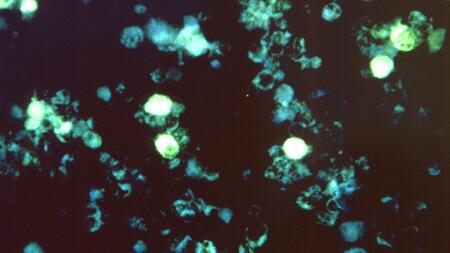Epstein-Barr Virus: Molecular Mechanism of Lymphoma Development Elucidated
Mit dem Epstein-Barr-Virus-infizierte Zellen in einer fluoreszenzmikroskopischen Aufnahme.
Epstein-Barr Virus (EBV) is widespread and very contagious: according to the World Health Association, more than 90 percent of the global population are infected with this virus throughout their lives. The virus causes B and T cell lymphomas (cancer of the lymphatic system) as well as carcinomas (epithelial cell cancer) in humans. In a recent study published in the journal Nature Communications, a team of researchers led by DZIF scientist Arnd Kieser at Helmholtz Munich unveiled the molecular basis for lymphoma development by EBV and identified a new and promising target structure for anti-EBV drug development.
Every year, around 160,000 people worldwide die from EBV-associated cancer. Infection with this virus is also a risk factor for the development of multiple sclerosis. Therefore, there is an urgent medical need for tailored therapies for EBV-associated diseases, and validated therapeutic targets for EBV-positive cancer are needed as starting points for drug development.
An oncogene is a gene that has the potential to cause cancer. Latent membrane protein 1 (LMP1) is the primary oncogene of EBV: It drives oncogenic cell transformation and tumour development. The authors show in the study that the viral LMP1 protein forms a direct complex with TRAF6, a protein derived from the host cell that is involved in biochemical signal transmission processes such as the activation of the NF-kappaB pathway (a cellular pathway, regulating genes involved in immunity, inflammation and cell survival). Furthermore, the researchers provide detailed insights into the molecular functions and structure of the LMP1-TRAF6 complex and demonstrate that the direct interaction of the two proteins is critical for LMP1 to activate the NF-kappaB pathway and to promote cell survival in lymphoma cells.
In summary, the LMP1-TRAF6 complex is identified as an important novel virus-host interface that is critical for the survival of EBV-positive lymphoma cells. By disrupting the direct complex of LMP1 and TRAF6 with inhibitory peptides it is possible to efficiently interfere with the survival of EBV-transformed human B cells. With this study the authors identify and validate the complex of LMP1 and TRAF6 as a promising novel therapeutic target structure in EBV-associated cancer, a breakthrough in the EBV and cancer field.“This publication and our studies on the interaction between the LMP1 protein of EBV and the cellular TRAF6 protein will allow the development of innovative inhibitory molecules as future drugs directed against EBV-driven cancer”, says Prof. Arnd Kieser, last author of the study and scientist at Helmholtz Munich and the German Center for Infection Research (DZIF).




